 Pirates and Privateers Pirates and Privateers
The History of Maritime
Piracy
Cindy Vallar, Editor
& Reviewer
P.O. Box 425,
Keller, TX 76244-0425
    
An Exception
to the Rule
. . . having now
discharged my Duty to you as a
Christian, by giving you the best
Counsel I can with respect to the
Salvation of your Soul, I must now do
my Office as a Judge.
The
Sentence that the Law hath appointed
to pass upon you for your Offences,
and which this Court doth therefore
award, is,
That you, the
said Stede Bonnet, shall go from
hence to the Place from whence you came,
and from thence to the Place of
Execution, where you shall be hanged by
the Neck till you are Dead.
And the God
of infinite Mercy be merciful to your
Soul.
(The Tryals of Major
Stede Bonnet, and Other Pirates,
43)
Nicholas
Trott, Esquire, Judge of the
Vice-Admiralty, and Chief-Justice of the
Province of South Carolina, pronounced
these words on 12 November 1718, but Stede
Bonnet’s fate was sealed long before that
fateful Wednesday. You might say his
descent began when he was six years old,
or in the aftermath of the death of his
firstborn, or when he left Barbados
without permission in 1716, or when he
opted to return to piracy after securing
the king’s pardon in 1718. Perhaps, it was
merely a culmination of a series of
missteps throughout his life, some of
which most certainly would have impacted
his mental state.
Rather than making a decision now, let us
begin at the beginning . . . 29 July 1688,
the day young Stede was christened at Christ
Church Parish Church.1 He
was a third generation Bonnet with roots
within British and Barbadian aristocracy.2
His grandfather was one of the original
settlers and served as the island’s Deputy
Colonial Secretary. John Whetstone had two
sons and a daughter; the latter married
Captain Edward Bonnet. Stede’s father died
in 1694 and his mother passed soon after.
The six-year-old inherited a sizable
estate, consisting of two windmills
and a mill used in the production of sugarcane,
which was cultivated on more than 400
acres by 94 slaves.
His grandmother, Jennet, took over raising
him once he turned eleven.
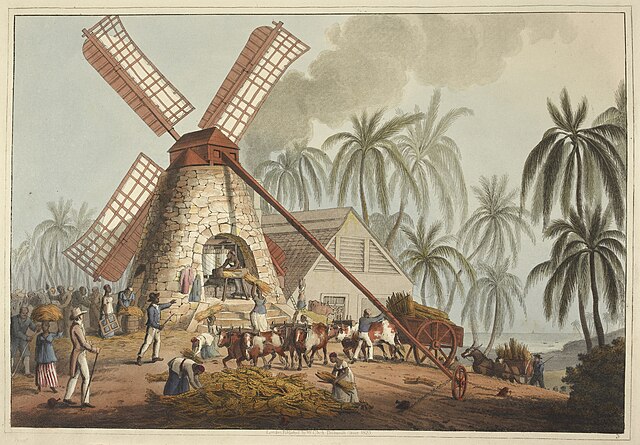 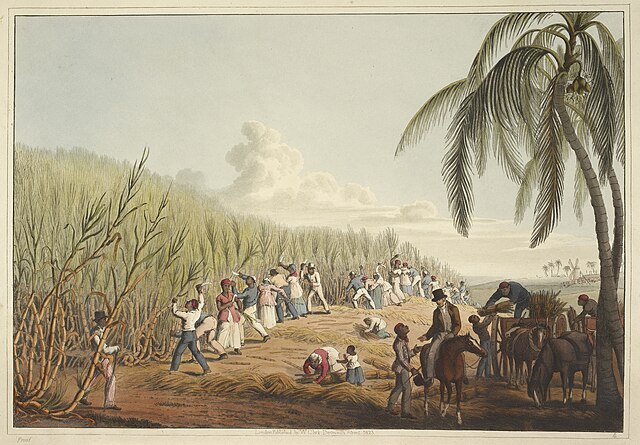
William Clark's
illustrations from Ten Views in
the Island of Antigua . . . (1823))
of a mill yard and slaves cutting
sugar cane
(Sources: Wikimedia
Commons and Wikimedia
Commons)
On 21 November 1709, Stede wed Mary
Allamby, whose father also owned a large
and successful plantation. Stede was
twenty-one and his bride was sixteen when
they walked down the aisle of the Cathedral
of St. Michael in Bridgetown. Three
years later, their first son, Allamby, was
born on 17 May. Two other sons, Edward
(1713) and Stede, Jr. (1714) followed, but
tragedy struck sometime during the early
years of this decade. Stede and Mary lost
their firstborn son. Allamby’s death, as
well as the death of Stede’s parents when
he was six, had to effect Stede, but
history doesn’t tell us how.3
Despite these losses, Stede’s life
continued to progress on a relatively
normal path. Being a landowner, he was
automatically granted a military rank in
the local militia. “Major” was more
honorary than earned, as there are no
extant records of his service and the
local government deemed it legally
necessary for the landowners to hold rank
to control the slaves. Even so, Stede
seemed to be proud of his title, using
“Major” even after he went on the account
instead of the more common “Captain.” In
January 1716, he became a Justice of the
Peace.
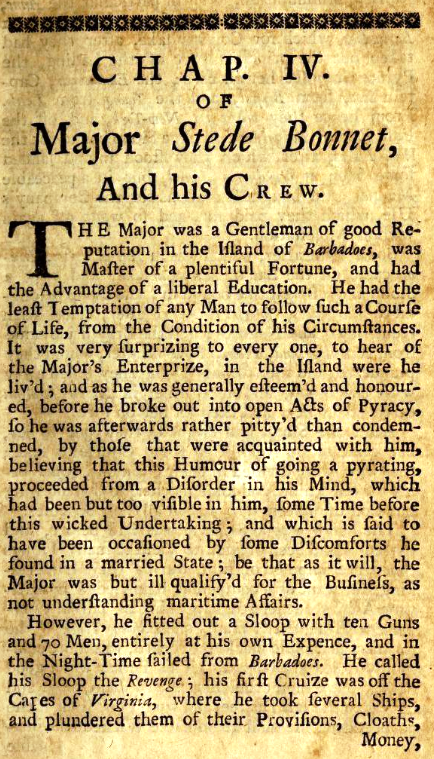 At some
point, according to Captain
Charles Johnson (whose writings
must be taken with a grain of salt), “a
Disorder in his Mind, which had been but
too visible in him,” surfaced.4
(Defoe, 95) Johnson attributed this to
“some Discomforts he found in the married
State” – which has been interpreted by
some to mean a nagging wife. (Defoe, 95)
These were two reasons given for his
switch from being a respected and
upstanding gentleman to becoming a pirate.
Others have suggested that the cumulative
effects of the losses he endured
could have pushed him over the edge until
he opted to “run away” from his life. Or
maybe he just experienced a mid-life
crisis. At some
point, according to Captain
Charles Johnson (whose writings
must be taken with a grain of salt), “a
Disorder in his Mind, which had been but
too visible in him,” surfaced.4
(Defoe, 95) Johnson attributed this to
“some Discomforts he found in the married
State” – which has been interpreted by
some to mean a nagging wife. (Defoe, 95)
These were two reasons given for his
switch from being a respected and
upstanding gentleman to becoming a pirate.
Others have suggested that the cumulative
effects of the losses he endured
could have pushed him over the edge until
he opted to “run away” from his life. Or
maybe he just experienced a mid-life
crisis.
Another possibility might stem from daydreams.
(We all have them.) Reading was a passion
of his, and he lived during a time when
several popular books explored exotic
voyages and privateering. These included
Captain Edward Cooke’s A
Voyage to the South Sea, and Round the
World, Lionel
Wafer’s A
New Voyage and Description of the
Isthmus of America, William
Dampier’s A
New Voyage Round the World,
and A
Cruising Voyage Round the World
by Woodes
Rogers, one of his relatives. He
might have wanted to follow in their
footsteps and go to sea.
There was just one problem: he didn’t know
the first thing about ships and sailing.
But why allow something this trivial to
stop him from pursuing his ambition? He
definitely had access to money and he did
take out a loan of £1,700. What the money
was for is unknown, but before the year
was out, he found just the right ship to
buy, a sixty-ton sloop
that sailed into Carlisle Bay from South
Carolina. Godfrey Malbone, master of the
vessel, agreed to Stede’s terms and Stede
paid the full price in cash. He also
arranged for a local shipwright to make
the necessary alterations so the sloop
could handle the armament that he wanted
(at least twelve guns) and an oversized
crew (at least 100 men). Stede made one
other request of the shipwright. His cabin
should be comfortable and have space to
house a library full of books.
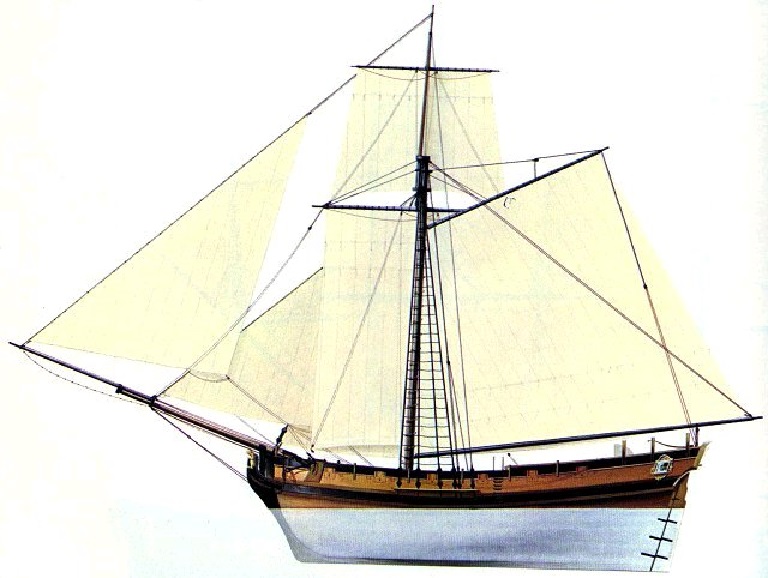 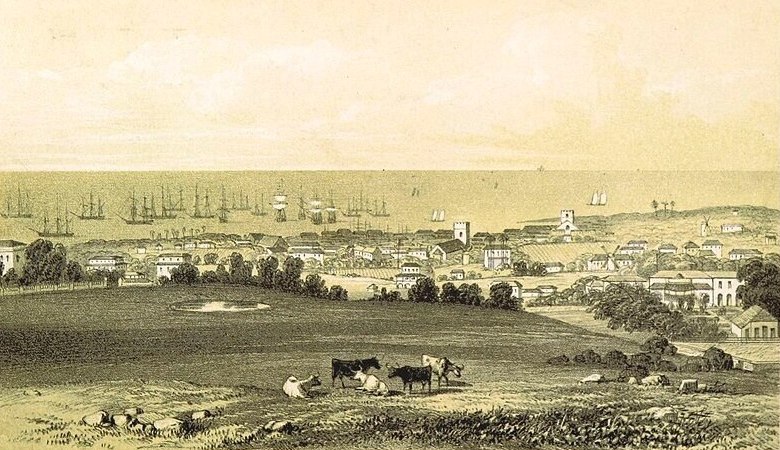
Drawing of a sloop
(left) and Lithograph of Bridgetown,
Barbados (1848, Source: Wikimedia
Commons)
While the shipwright went to work, Stede
put his affairs in order. His wife, Mary,
had his power of attorney and two friends
would oversee all personal and business
matters pertaining to the family. Since he
lacked seamanship, Stede needed a crew who
knew the ins and outs of sailing and
working the ship. By the time he left
Barbados in late spring of 1717, he had
hired 126 experienced men. Purchasing and
finding twelve cannons proved problematic,
so he settled for six with a magazine that
was fully stocked with gunpowder, round
shot, and small arms. Then, in the dark of
night, he and his men weighed anchor and
departed Carlisle Bay, never to return.
Doing so without permission, which is what
Revenge did, meant that Stede had
already committed his first crime.
Continue
reading
Notes:
1. This
would be the second building of that
name, since the 1629 wooden Christ
Church was destroyed in 1669. Rebuilt on
the site, the new church was of stone
and could accommodate 300 people. A
hurricane destroyed the church in 1780,
but several other renditions have been
erected since then.
https://www.christchurchpc.com/history-architecture
2.
Genealogy research conducted by Baylus
C. Brooks shows that Stede Bonnet’s
great-great-grandfather, Roger Whitstone
was married to Oliver Cromwell’s sister.
They had two sons, one of whom was Sir
Thomas Whetstone, whose second wife was
the daughter of one of the men executed
for beheading King Charles I. The other
son, Capt. John Whetstone was the
grandfather of Sarah Whetstone, who
married Woodes Rogers, the future
governor of the Bahamas.
3. Allamby’s death
would be equally devastating on Mary,
but no records exist that indicate what
those effects were.
4. No contemporary
document corroborates Johnson’s claim,
but it is frequently mentioned in
subsequent biographies.
Resources:
Baker,
Daniel R. "Stede Bonnet: The Phantom Alliance,"
The Pyrate's Way, Summer 2007, 21-25.
British Piracy in the Golden Age: History and
Interpretation, 1660-1730 edited by Joel
H. Baer. Picekring & Chatto, 2007,
2:321-380.
Brooks, Baylus C. Quest for Blackbeard: The
Story of Edward Thache and His World.
Independently published, 2016.
Cordingly, David. Under the Black Flag: The
Romance and the Reality of Life Among the
Pirates. Random House, 1995.
Defoe, Daniel. A General History of the
Pyrates edited by Manuel Schonhorn. Dover,
1999.
Dolin, Eric Jay. Black Flags, Blue Waters:
The Epic History of America's Most Notorious
Pirates. Liveright, 2018.
Downey, Christopher Byrd. Stede Bonnet:
Charleston's Gentleman Pirate. The History
Press, 2012.
Duffus, Kevin P. The Last Days of Black
Beard the Pirate. Looking Glass
Productions, 2008.
Malesic, Tony. "Richard Tookerman," E-mail
posted on Pirates List, 26 September 2001.
Marley, David F. "Bonnet, Stede (fl.
1717-1718)," Pirates of the Americas.
ABC-CLIO, 2010, 2:527-533.
Moss, Jeremy R. The Life and Tryals of the
Gentleman Pirate, Major Stede Bonnet.
Köehler, 2020.
Moss, Jeremy. "Stede
Bonnet, Gentleman Pirate: How a Mid-life
Crisis Created the 'worst pirate of all time',"
History Extra, 4 January 2023.
The
Tryals of Major Stede Bonnet, and Other
Pirates. Printed for Ben J. Cowse at
the Rose and Crown, MDCCXIX.
Woodard, Colin. The Republic of Pirates:
Being the True and Surprising Story of the
Caribbean Pirates and the Man Who Brought Them
Down. Harcourt, 2007.
Copyright ©2024 Cindy Vallar

Click to contact me
Background image compliments
of Anke's Graphics |

